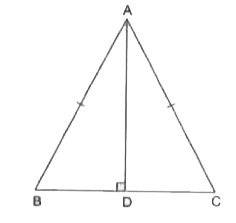If one side of a triangle is double the other, and the angles opposite to these sides differ by 60∘, show that the triangle is right-angled.
To solve the problem, we need to show that the triangle is right-angled given the conditions. Let's denote the sides of the triangle as follows:
- Let side a be the longer side.
- Let side b be the shorter side.
According to the problem, we have:
1. a=2b (one side is double the other)
2. Let the angles opposite to sides a and b be A and B respectively. We know that A−B=60∘ (the angles differ by 60∘).
Step 1: Express the angles in terms of B
From the second condition, we can express angle A as:
A=B+60∘
Step 2: Use the triangle angle sum property
The sum of angles in a triangle is 180∘:
A+B+C=180∘
Substituting A from Step 1:
(B+60∘)+B+C=180∘
This simplifies to:
2B+C+60∘=180∘
2B+C=120∘
Thus, we can express C as:
C=120∘−2B
Step 3: Apply the Law of Sines
According to the Law of Sines:
asinA=bsinB
Substituting a=2b and A=B+60∘:
2bsin(B+60∘)=bsinB
Step 4: Simplify the equation
Dividing both sides by b (assuming b≠0):
2sin(B+60∘)=1sinB
Cross-multiplying gives:
2sinB=sin(B+60∘)
Step 5: Use the sine addition formula
Using the sine addition formula:
sin(B+60∘)=sinBcos60∘+cosBsin60∘
Substituting cos60∘=12 and sin60∘=√32:
sin(B+60∘)=sinB⋅12+cosB⋅√32
Thus, we have:
2sinB=12sinB+√32cosB
Step 6: Rearranging the equation
Rearranging gives:
2sinB−12sinB=√32cosB
32sinB=√32cosB
Dividing both sides by 12:
3sinB=√3cosB
Step 7: Divide by cosB
Dividing both sides by cosB (assuming cosB≠0):
3tanB=√3
Thus:
tanB=√33
This implies:
B=30∘
Step 8: Find angle A
Using A=B+60∘:
A=30∘+60∘=90∘
Step 9: Find angle C
Using the triangle angle sum property:
C=180∘−(A+B)=180∘−(90∘+30∘)=60∘
Conclusion
Since angle A=90∘, we have shown that the triangle is a right-angled triangle.
- Let side b be the shorter side.
1. a=2b (one side is double the other)
2. Let the angles opposite to sides a and b be A and B respectively. We know that A−B=60∘ (the angles differ by 60∘).
From the second condition, we can express angle A as:
A=B+60∘
The sum of angles in a triangle is 180∘:
A+B+C=180∘
Substituting A from Step 1:
(B+60∘)+B+C=180∘
This simplifies to:
2B+C+60∘=180∘
2B+C=120∘
Thus, we can express C as:
C=120∘−2B
According to the Law of Sines:
asinA=bsinB
Substituting a=2b and A=B+60∘:
2bsin(B+60∘)=bsinB
Dividing both sides by b (assuming b≠0):
2sin(B+60∘)=1sinB
Cross-multiplying gives:
2sinB=sin(B+60∘)
Using the sine addition formula:
sin(B+60∘)=sinBcos60∘+cosBsin60∘
Substituting cos60∘=12 and sin60∘=√32:
sin(B+60∘)=sinB⋅12+cosB⋅√32
Thus, we have:
2sinB=12sinB+√32cosB
Rearranging gives:
2sinB−12sinB=√32cosB
32sinB=√32cosB
Dividing both sides by 12:
3sinB=√3cosB
Dividing both sides by cosB (assuming cosB≠0):
3tanB=√3
Thus:
tanB=√33
This implies:
B=30∘
Using A=B+60∘:
A=30∘+60∘=90∘
Using the triangle angle sum property:
C=180∘−(A+B)=180∘−(90∘+30∘)=60∘
Since angle A=90∘, we have shown that the triangle is a right-angled triangle.
Topper's Solved these Questions
- BOOK - MARVEL PUBLICATIONCHAPTER - TRIGONOMETRIC FUNCTIONSEXERCISE - MULTIPLE CHOICE QUESTIONS - PART - A : BUILDING-UP THE BASE152videos
TRIGONOMETRIC FUNCTIONS
- BOOK - MARVEL PUBLICATIONCHAPTER - TRIGONOMETRIC FUNCTIONSEXERCISE - MULTIPLE CHOICE QUESTIONS - PART - A : BUILDING-UP THE BASE (B) Properties of triangles27videos
TRIGONOMETRIC FUNCTIONS
- BOOK - MARVEL PUBLICATIONCHAPTER - TRIGONOMETRIC FUNCTIONSEXERCISE - TEST YOUR GRASP: CHAPTER 3-3.313videos
TRIGONOMETRIC FUNCTIONS
- BOOK - MARVEL PUBLICATIONCHAPTER - THREE DIMENSIONAL GEOMETRYEXERCISE - MULTIPLE CHOICE QUESTIONS39videos
THREE DIMENSIONAL GEOMETRY
- BOOK - MARVEL PUBLICATIONCHAPTER - VECTORSEXERCISE - TEST YOUR GRASP20videos
VECTORS
Similar Questions
If one side of a triangle is double the other, and the angles opposite to these sides differ by 60∘, show that the triangle is right-angled.
View SolutionIf one side of a triangle is double the other, and the angles on opposite sides differ by 600, then the triangle is equilateral (b) obtuse angled (c) right angled (d) acute angled
View Solution
Knowledge Check
- Question 1 - Select One
If one side of a triangle is double the other and the angles opposite to these sides differ by 60∘, then the triangle is
Aobtuse angledBacute angledCIsoscelesDright angled - Question 2 - Select One
If one side of a triangle is double the other, and the angles on opposite sides differ by 60∘, then the triangle is
AequilateralBobtus angledCright angledDacute angled
In a triangle the greater angle has the longer side opposite to it.
View SolutionIf two sides of a triangle are unequal; the longer side has greater angle opposite to it.
View Solutionin one angle of a right triangle is 60∘ ,the other two angle are
View SolutionIf one angles of a triangle is equal to the sum of the other two, show that the triangle is right angled.
View SolutionShow that in an isosceles triangle, the angles opposite to the equal sides are equal.
 View Solution
View SolutionIn a triangle , the shortest side has the smallest angle opposite to it .
View Solution

